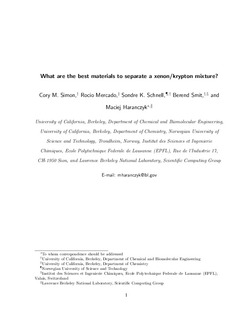What Are the Best Materials To Separate a Xenon/Krypton Mixture?
Journal article, Peer reviewed
Accepted version
Permanent lenke
http://hdl.handle.net/11250/2465205Utgivelsesdato
2015Metadata
Vis full innførselSamlinger
- Institutt for kjemi [1391]
- Publikasjoner fra CRIStin - NTNU [38013]
Sammendrag
Accelerating progress in the discovery and deployment of advanced nanoporous materials relies on chemical insight and structure–property relationships for rational design. Because of the complexity of this problem, trial-and-error is heavily involved in the laboratory today. A cost-effective route to aid experimental materials discovery is to construct structure models of nanoporous materials in silico and use molecular simulations to rapidly test them and elucidate data-driven guidelines for rational design. For example, highly tunable nanoporous materials have shown promise as adsorbents for separating an industrially relevant gaseous mixture of xenon and krypton. In this work, we characterize, screen, and analyze the Nanoporous Materials Genome, a database of about 670 000 porous material structures, for candidate adsorbents for xenon/krypton separations. For over half a million structures, the computational resources required for a brute-force screening using grand-canonical Monte Carlo simulations of Xe/Kr adsorption are prohibitive. To overcome the computational cost, we used a hybrid approach combining machine learning algorithms (random forests) with molecular simulations. We compared the results from our large-scale screening with simple pore models to rationalize the strong link between pore size and selectivity. With this insight, we then analyzed the anatomy of the binding sites of the most selective materials. These binding sites can be constructed from tubes, pockets, rings, or cages and are often composed of nondiscrete chemical fragments. The complexity of these binding sites emphasizes the importance of high-throughput computational screenings to identify optimal materials for a given application. Interestingly, our screening study predicts that the two most selective materials in the database are an aluminophosphate zeolite analogue and a calcium based coordination network, both of which have already been synthesized but not yet tested for Xe/Kr separations.
